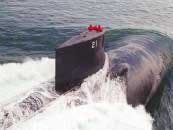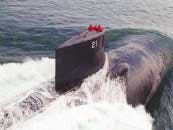By J.R. Wilson
WASHINGTON — The new generation of U.S. Navy submarines represents a significant advance in technology and an equally significant change in mission and capability.
The new all-electric modular Virginia-class fast-attack submarines (SSN 774) and the reconfigured guided-missile boats (SSGN, converted from SSBN) are designed for shallow-water and special operations. To accomplish that, they incorporate a variety of new communications and other advanced electronics equipment, drawing heavily on commercial developments.
"The primary enabler, so far as the combat systems are concerned, is the growth in processor speed and capability," says Will Lennon, Virginia program manager at prime contractor General Dynamics Electric Boat in Groton, Conn. "The COTS electronics, in terms of capabilities for processing and speed, far outweigh any previous class military versions."
The Virginia's open architecture relies on a standard protocol for system interaction; all the subsystem developers agreed to abide by this protocol, Lennon says. While the Virginia's software applications are customized for the military, the vessel's software operating systems are standard commercial. "We then buy components off the shelf with very little customization or militarization," he says.
U.S. Navy Rear Adm. Michael Tracy, director of the Submarine Warfare Division on the staff of the chief of naval operations in the Pentagon, says the key to the expanded capability of the reconfigured SSGNs and the new Virginia is their advanced communications capability.
Scalable architecture
The Virginia communications suite "is like the whole sub built to be scalable, sustainable, and accommodate changes with future integration of technology. It no longer requires major modifications to do significant reconfiguration — just put in the new module."
The external communications system of the Virginia will support high data throughput to reduce operator workload, and will support the global command and communications (C2) system (ForceNet) — a high-bandwidth backbone to integrate a common picture to the battle group, Tracy says.
The submarine's communications system will allow for an undersea autonomous communications link with unmanned underwater vehicles (UUVs), will reduce the time necessary to provide crucial data to combatant commanders, and will substantially improve the undersea portion of the common tactical picture, Tracy says.
The first submarine designed for battlespace dominance across the broad spectrum of littoral and open-water missions, the Virginia can move to remote locations at sustained high speeds, can provide persistent covert surveillance capability, and features an open-system architecture design that supports reconfiguration for long-term future capabilities growth, Lennon says.
In previous programs the combat system providers brought in their own hardware — down to the cabinets — and installed them at the shipyard for delivery with the ship ... "which means it could have been obsolete by delivery," Lennon says.
Commercial electronics
Instead, the entire Virginia combat system is based on commercial electronics, he says. The Virginia has a structurally integrated enclosure (SIE), with standard commercial rack space for electronics, which includes power and cooling.
"The combat system providers then come in with drawer-level components and plug them into our shipboard architecture, so if you want to do a technology insertion or upgrade, you just take out the old drawers and put in new ones, rather than cutting out the old cabinets and bringing in new ones. So we can quickly refresh the electronics," Lennon says.
"There are certain areas of the ship where ruggedized equipment is required because they can't be insulated enough, but the combat system is primarily COTS," Lennon continues. The ship design enables us to isolate those components so shock levels can be met and acoustic performance maintained, which is a significant advancement for the submarine force."
That ease of update already has been demonstrated on the lead ship, which General Dynamics will not deliver until May 2004. The second ship in the series has newer technology in its command-and-control module, and once testing is finished, the advanced hardware will be removed from the second ship and installed on the lead vessel for when it does go to sea. Navy officials accomplished the refresh without replacing the entire module or making any structural changes to either submarine.
The all-electric design incorporates significant changes for how information is acquired, fused and shared aboard the ship as well as with other theater assets. For example, instead of an optical periscope using a series of prisms and mirrors, the Virginia sports an electronic periscope, a photonics mast with color, infrared, and high-definition black-and-white cameras. This enables the crew to see more than ever, including at night and in bad weather. With zoom capability and a laser range finder, it also can determine range to any particular feature on the water.
"Since it is electronic, you can distribute throughout the ship what formerly only the officer of the deck could see through the periscope," says Capt. John Heffron, Virginia program manager at Naval Sea Systems Command in Washington.
Data distribution
"We have a wireless communication system where a crewman can wear a headset and walk around. We also have an integrated set of electronics systems in the forward end of the ship," Heffron says. "Basically, sonar, combat control, radio, and interior communications are all interconnected, so the ability to pass information from one component to another is greatly enhanced."
Improved external communications also are not limited to ship's business, but extend to personal messages, as well.
"In the old days, when you were on patrol you were limited to a very few short messages because of the low data rate. With the capability on this ship, every sailor will have his own computer and e-mail account and will be able to e-mail off and receive messages from his family much more rapidly and in greater length and volume that before," Heffron says. "It won't be instantaneous, because you can only transmit and receive when you are at periscope depth, but it is much greater capability than before."
The new SSGN, meanwhile, is a transformational boat, taking advantage of the existing Ohio-class "Trident" ballistic missile submarine (SSBN 726) infrastructure. Essentially the same radio room and ISR (intelligence, surveillance and reconnaissance) suite designed for the Virginia is being placed into the SSGN, with a few added extras, such as two high-rate data antennas and two follow-on terminals. With these, the new missile submarine can handle strike and special operations forces (SOF) missions. A new battle management system will help plan missions as well as handle SOF mission control.
"On SSGN, we have a more limited application of COTS than Virginia or future platforms," notes Electric Boat's SSGN program manager, John Biederka. "The SSBN was designed 20 years ago and so does not have embedded in its basic design the Virginia's ability to bring in COTS and have it meet the military requirement."
One exception is the Navy's Common Submarine Radio Room, used for the Virginia, SSGN, and Seawolf-class (SSN-21) fast attack boat. To a lesser extent, another is the attack weapons-control system, which leverages government off-the-shelf technology from the existing Tomahawk weapons-control system to replace the SSBN's strategic weapons-control system.
Advanced sensors
A few significant advances in submarine sensors also will provide a major boost to the mission capabilities of the new subs, especially given the ease of upgrade supported by modern hardware and software architectures.
"Advanced rapid COTS technology insertion for the sonar suite, in particular, utilizes annual program builds," Tracy says. "Our engineering measurement program identifies hardware and software changes to be incorporated into the annual program-built process to basically improve tactical control. That process has given us lower cost, lighter weight and better performance, along with improved processing, aperture, hold time, detection ranges and reliability.
"Our sensor technology is improving with time," Tracy continues. "A new combat control system on the Virginia class will give us improved weapon control from download capability for special missions to improved engagement planning processes more automation, improved electronic plots capability, drag-and-click operations on a periscope, flat-panel displays, and data fusion options that make the control area more user friendly for operators and provide better knowledge management for command."
Tracy calls ForceNet the "glue" that will enable all elements of the Navy to bring a new level of precision and persistent offensive power to the nation's future maritime warfighting capabilities. To do that, submarines probably will operate somewhat less autonomously in an expeditionary environment, requiring a better interface with the common operational picture.
Network-centric warfare
"One of our specific focuses and an area where we are looking for greater development is communications at speed and at depth. To handle the variations of different profiles, we must be even more timely in our communications and more robustly interoperable with whatever forces are assigned to those operations," he says. "We're looking at a ship-wide fiber-optic tactical network to enhance ForceNet within the next decade. We'd also like to have the new combat control system on all SSNs by 2012; it provides better information management of tactical data and exports it to the new high information, complex littoral environment. As the technology moves along, the plan is to install it on new boats as well as backfit to the Los Angeles-class attack submarines (SSN-688).
"We're not singly focused on any one particular threat we may go up against, but designing our system to be able to handle the full spectrum of threats we think will exist in the next century. That's what modularity is all about to be able to handle that threat through the course of this century and have a superior submarine that can adapt to changes."
Al Malchiodi, Electric Boat's concept formulation director, says the new submarine electronics will make them a real player, for the first time, in the network centric effort being formulated by the Space & Naval Warfare Systems Command (SPAWAR).
"It's not aboard the ship but getting the information through the water and how much of that can we do," he says of challenges to the collection and transmission of information." Antennas have been upgraded to offer significant bandwidth to submarines today, including the Virginia, the SSGN, and eventually even the 688 attack boats.
Because interoperability, more than ever, also will involve coalition assets, Navy leaders are working closely with allied submarine forces to define and implement requirements and capabilities for the evolving network-centric communications architecture. Tracy says the pace on U.S. vessels may be significantly more developed at this stage, but it is imperative to ensure sufficient interoperability so that it doesn't become an Achilles' heel to future operations.
"The real value of the Virginia class and SSGN is battlespace dominance in the undersea environment. The Virginia is the best sub ever built for littoral operations, but it also can function in a multimission environment where connectivity, flexibility and joint operability will be key to our undersea forces," he says.
"We're also looking at future improvements that will be far more enhanced than what was available in the Los Angeles class. Technology advancements for the Virginia will change the way the SSGN operates and will have a major impact on how the future submarine fleet operates. We have a unique competitive advantage in undersea warfare advanced and unique technology, sophisticated engineering, unique infrastructure and, most importantly, experience. We need to continue to use that to its ultimate. That advantage offers us the ability for not just superiority but warfighting dominance in the future."




